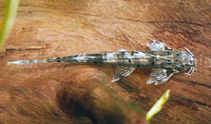| Family: |
Amphiliidae (Loach catfishes), subfamily: Doumeinae |
| Max. size: |
9 cm TL (male/unsexed) |
| Environment: |
demersal; freshwater; pH range: 6.30000019073486 - 7.19999980926514; dH range: 10 - 18 |
| Distribution: |
Africa: lower Niger, Niger delta and Oshun River in Nigeria (Ref. 57128). Also reported from the Mono River basin in Togo (Ref. 3045, 57128). |
| Diagnosis: |
Dorsal spines (total): -1; Dorsal soft rays (total): 6; Anal spines: 2; Anal soft rays: 9. Diagnosis: pectoral-fin tips reaching to pelvic-fin bases; pelvic-fin insertions located on a vertical line from last dorsal-fin ray: snout length less than 55% of head length; posterior nostrils large, separated from orbits by a bony crest; humeral process blunt; branchiostegal membrane broadly notched ventrally; width of occipital process comprised 3.2 times in its length (Ref. 57128).
Description: body elongate, narrower towards caudal fin; head triangular, snout pointed, with a median, posteriorly bifurcate, bony crest; eyes rather large, with a supraorbital swelling and a bony crest above and below cheeks; mouth subterminal, barbels simple, short and thin; supraoccipital process moderately long and bluntly pointed, separated by a short distance from dorsal-fin base; humeral process well developed, oblong and blunt; an additional bony process present between the humeral and supraoccipital ones; dorsal fin triangular, positioned ahead of pelvic fins, its anterior ray minute and spinous; pectoral and pelvic fins falcate, their principal ray broad and filamentous; pectoral-fin tips reaching to pelvic-fin bases, and pelvic-fin tips to anal-fin base; anal fin with 2 spines and 9 branched rays; adipose fin small, placed above posterior part of anal fin and preceded by a short spine located at the end of a mid-dorsal bony crest; caudal peduncle long and slender, encased by bony plates; caudal fin small and triangular, with a semilunar posterior margin; a series of 25 bony plates on either side of back, from dorsal fin to caudal peduncle; a second series of 21 bony plates on either side of belly, between pelvic fins and caudal peduncle; 7+8 principal caudal fin rays (Ref. 57128).
Coloration: pale brown with black spots, belly white; 2 small black spots on dorsal fin and 3 blackish lines on caudal fin (Ref. 57128). |
| Biology: |
Phractura species are often associated with the vegetation of flowing waters (Ref. 57128). |
| IUCN Red List Status: |
Endangered (EN); Date assessed: 14 August 2019 (B2ab(i,ii,iii,iv)) Ref. (130435)
|
| Threat to humans: |
harmless |
Source and more info: www.fishbase.org. For personal, classroom, and other internal use only. Not for publication.
